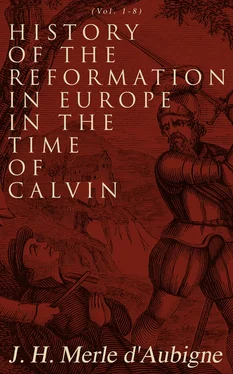Berthelier’s firmness paralysed all the diplomatist’s efforts; and it was decided that the duke himself should visit Switzerland. Making a pretence of business at Geneva and Lausanne, Charles III. arrived at Friburg and Berne. He endeavoured to win over the cantons, induced them to dissuade the king of France from making war upon him, renewed his alliance with the League, and as they complained of the tyranny of his cousin the bishop, of the illegal arrest of Pécolat, and of Berthelier’s exile, he made them all the fairest promises. 126
But he reckoned without his host: the bishop who had a meaner character than the duke, had also a more obstinate temper. As his illustrious cousin had visited Switzerland, it was his duty to be there to receive him; he had accordingly returned to Geneva, and as some sensible men had made him understand how deeply he was compromised in D’Orsières’ arrest, he set the good old man at liberty. If he consented to yield on this point, he was determined not to give way on others. When the syndics complained to him of the irregularities committed within the city and without, representing to him that citizens were arrested without cause, and that too, not by the officers of justice, but—a thing unprecedented—by his own archers, the prelate was deaf; he turned away his head, looked at what was going on around him, and dismissed the magistrates as politely as he could. Accordingly when the duke returned from Friburg, the syndics laid all their grievances before him: ‘Our franchises are infringed by the bishop. A citizen cannot be arrested beyond our boundaries, yet Pécolat was seized at Pressinge. All criminal cases fall within the syndics’ jurisdiction, yet Pécolat has been tried by the episcopal officers.’ Whereupon the bishop and the duke, wishing to have the appearance of giving some little satisfaction to the Swiss and the Genevans, transferred Pécolat from his prison at Thiez to Geneva, and shut him up in the Château de l’Ile. But neither the duke nor the bishop dreamt of letting him go; would they ever have a better opportunity of showing the cardinals that the bishop’s life was in danger? But if Pécolat should appear before the syndics, his judges, would he be condemned? The duke’s friends shook their heads. ‘One of them, the elder Lévrier, an incorrigible dotard,’ they said, ‘would sooner be put in prison, as in 1506, than give way; another, Richardet, a hot-headed fellow, would wax wroth, and perhaps draw his sword; and Porral, a wag like his elder brother, would turn his back and laugh at the Mamelukes!’
CHAPTER X.
FRESH TORTURES, PÉCOLAT’S DESPAIR AND STRIKING DELIVERANCE.
Table of Contents
Pécolat’s condemnation became the chief business of the court of Turin in its relations with Geneva. Archbishop Seyssel, who at that time possessed great influence, was not for despotism: he approved of moderating the royal authority, but hated republics, and wished to take advantage of Pécolat’s trial to crush the spirit of liberty, which was displaying so much energy in Geneva, and which might spread farther. Feeling the importance of this case, in combating the Huguenot influence, the archbishop determined to withdraw, if possible, the Genevan from his natural judges, and resorted to a trick unworthy so great a statesman. He represented that high treason, the crime of which Pécolat was accused, was not one of those comprehended under the constitutions of the city, and that the cognisance belonged therefore to the prince; but he could not succeed. ‘We have the power,’ answered the syndics, ‘to take cognisance of every criminal case.’ All that Seyssel could obtain was that the bishop should appoint delegates who would sit in court and give their opinion, but not vote. 127
The judges met in the Château de l’Ile on the 10th of December, 1517; they were surrounded by the duke’s and the bishop’s attorneys, the governor of Vaud, and other partisans of Savoy. Among the six councillors who were to sit with the syndics (the judges being thus ten in number), were some decided ducal partisans, upon whom the bishop could rely for a sentence of condemnation. Poor Pécolat, still suffering, was brought in by the vidame. The sight of the syndics—of the elder Lévrier, Richardet, and Porral—revived his courage: he knew that they were just men and enemies of episcopal despotism. ‘The confessions I made at Thiez,’ he said, ‘were wrung from me by torture: the judge dictated the words and I repeated them after him. I knew that if I did not say what they wanted, they would break my arms, and maim me for ever.’ 128
After this declaration, the examination began: the clearness of Pécolat’s answers, his gentleness and candour, showed all present that they had before them an innocent man, whom powerful princes desired to destroy. The syndics having declared that they were bound to acquit him, the bishop said: ‘Give him the question, and you will see clearly that he is guilty.’ The syndics refused, whereupon the two princes accused them of being partial and suspected men. The episcopal council, therefore, decided, that the city and the bishop should each appoint four judges—an illegal measure, to which the syndics submitted.
The new examination ought to have taken place on the 20th of January, 1518; but Pécolat, suffering from the torture past and terrified by the torture to come, had fallen seriously ill, and it was necessary to send the doctor to him. This man consented to his being carried before the court. The four episcopal judges immediately called for the question, but the syndics opposed it, and the episcopal delegates began to study this living corpse. After examining him attentively they said: ‘He still affords some hold for the torture; he may be examined with a few torments ’ (such is the expression in the report). Nergaz siding with the Savoyard doctors, the torture was decided upon. Poor Pécolat began to tremble from head to foot; he knew that he should denounce all his friends, and cursed his own weakness. They tied his hands behind his back, they showed him the rack, and interrogated him.... ‘However, they did not torture him,’ continues the report, ‘considering the weakness of his body and his long imprisonment.’ They thought that the fear of the rack would suffice to make him speak; they were deceived; the sick—we might almost call him the dying man, though tied up and bound, having the instrument of torture before him, answered with simplicity and frankness. Even the bishop’s judges were struck with his candour, and two of them, ‘having the fear of God before their eyes,’ says Bonivard, rather than the fear of men, declared roundly : ‘They have done this poor man wrong. Non invenimus in eo causam. We find no fault in him.’ 129
This honourable declaration embarrassed the duke all the more that he had other anxieties on his mind. The news from Piedmont was bad: every day he received letters urging him to return. ‘The Marquis of Montferrat.’ they told him, ‘is committing serious depredations.’ But the headstrong prince was ready to lose his own states, if he could but get Geneva—and lose them he did not long after. Finding himself on the point of discovering a conspiracy, calculated to satisfy the cardinals, he resolved not to yield. His creatures and those of the prelate held conference after conference; at last they found a means—a diabolical means—of putting Pécolat to death. Seeing that lay judges were not to be persuaded to condemn an innocent man, they resolved that he should be tried by priests. To put this plan into execution, it was necessary to change the layman—the ex-hosier, the merry fellow who was at every banquet and every masquerade—into a churchman. They succeeded. ‘To gratify their appetite,’ said Bonivard, ‘they produced a forged letter, to the effect that Pécolat was an ordained clerk ... and therefore his case belonged not to the secular, but to the ecclesiastical judge.’ The fraud found, or seemed to find belief in the official world. ‘Accordingly,’ goes on the chronicle, ‘they transferred him from the Château de l’Ile, which was the lay prison, to the bishop’s palace which was the Church court, and he was placed once more in the hands of the Pharisees.’ This was a stroke worthy of a celebrated religious order not yet in existence, but which was about to be founded to combat the Reformation. Henceforth we shall see none of that silly consideration, of that delicate circumspection, which the laymen had employed. The bishop, now become judge and party, ‘deliberated how to handle him well.’ Some persons having asserted that Pécolat could not endure the rack, the doctors again examined his poor body: some said yes and others no, so the judges decided that the first were right, and the instrument of torture was prepared. It was not only heroic men like the Bertheliers and Lévriers, who, by their daring opposition to arbitrary power, were then raising the edifice of liberty; but it was also these wicked judges, these tyrannical princes, these cruel executioners, who by their wheel and rack were preparing the new and more equitable times of modern society. 130
Читать дальше







![Hubert Bancroft - The Native Races [of the Pacific states], Volume 5, Primitive History](/books/749157/hubert-bancroft-the-native-races-of-the-pacific-s-thumb.webp)




